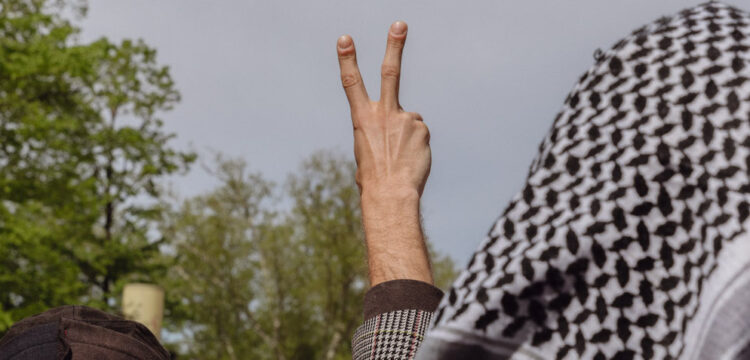We Want Everything Else!
Anatomy of a movement
What happens when people rediscover the power of walking together in the streets for hours on end, so much so that they sit down on the pavement and forget to go home? Hugging each other, not feeling alone, singing, almost shouting, without hearing their own voice as it blends in with those around. What is happening? Children, teachers, students, workers, porters, graphic designers, artists, parliamentarians, tram drivers, basically everyone. Everyone who for months has seen, heard, come and gone, cried and got angry, and now has said enough is enough.
Israel is today the most dangerous democratic-authoritarian, terrorist and fundamentalist state in the world. The United States supports it because white supremacists and colonialists have adopted Israeli Zionism as their favourite child. Timid and subordinate, Europe is held in check by Italy and Germany: the same fascist-Nazi axis that ruled it a century ago.
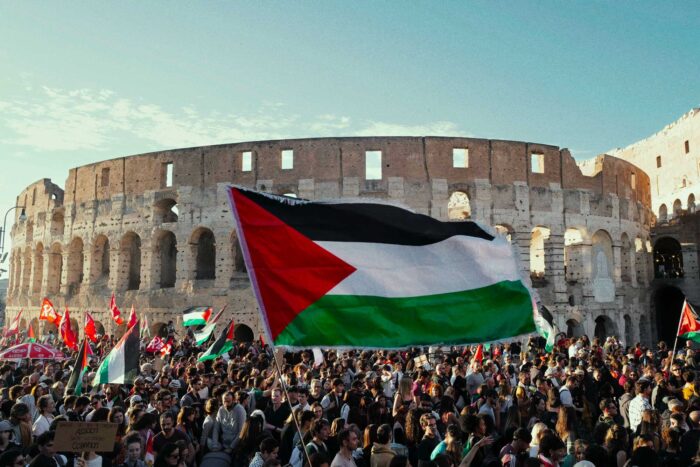
We haven’t seen a square of this size in years. Both the movements and society are striking: political organisations are inadequate, but some are following and putting themselves at the service of the movement. The strike is social, the squares are crowded and the movement has a constituent force. What does this mean? That we must ask ourselves what will happen in the coming months.
There were many slogans and banners in this strike against the genocide in Gaza and against fascist repression in Italy. I would like to highlight one in particular: that of the national platform of art, culture and entertainment workers, created in response to the cuts that the Meloni government has imposed on public funding for independent arts: “VOGLIAMO TUTT’ALTRO” — WE WANT EVERYTHING ELSE, that is we want something completely different.
This slogan brings together two genealogies: on the one hand, Nanni Balestrini’s “We want everything,” which encapsulated the cycle of workers’ struggles up to the 1970s; on the other, “Another world is possible,” the slogan of the next cycle, from the social forums of the 1990s to the Seattle movement, to the pacifist mobilisations against the war in Iraq and the constituent struggles for the commons and transfeminists at the beginning of the new millennium. The current cycle inherits those experiences and genealogies. And that is precisely why we must pause for a moment to understand what really characterises it.
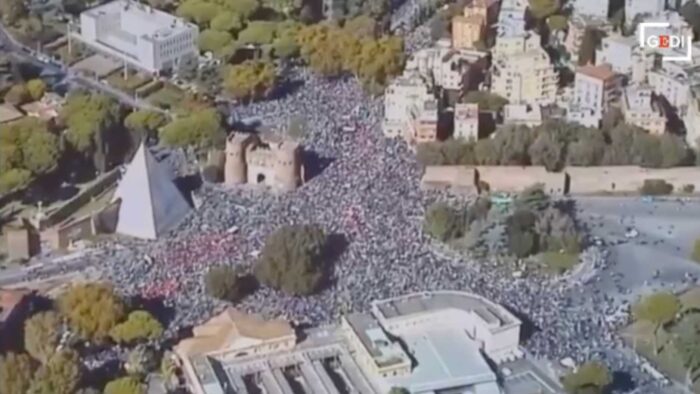
This movement started with the Palestinian resistance and was able to spread, first and foremost, to the networks of knowledge in our territories: first to students, with the encampments that began in 2024 in universities in the United States and Europe; then the world of art and culture, which took a stand against censorship and complicity with Israel—from the ANGA (Art Not Genocide Alliance) network in 2024 to the boycott of Israeli participation in the Venice Biennale, to Galassia antisionista, which investigates the complicity between cultural institutions and the arms industry, to the Venice Film Festival; then logistics and ports, starting with the first campaigns in 2024 against the complicity between MAERSK and F35, launched among others by the US writers’ network WAWOG (writers against the war on Gaza). In 2025, in Italy, dockworkers in Genoa, Venice, Ancona, Livorno, Naples, Palermo and Civitavecchia stopped arms convoys bound for Israel, relaunching the slogan BLOCCHIAMO TUTTO—LET’S SHUT EVERYTHING DOWN.
It is a movement that practises convergence. As we had already observed and discussed at theWorld Congress for Climate Justice held in Milan in 2023 (WWCJ), European eco-activism is destined to meet with the anti-imperialist movements of the global South and with pacifist movements. Greta Thunberg, along with many other leaders of territorial and global struggles, has recognised that the black hole of the ongoing genocide in Gaza has taken on the tactical and strategic significance of the “struggle of all struggles.”
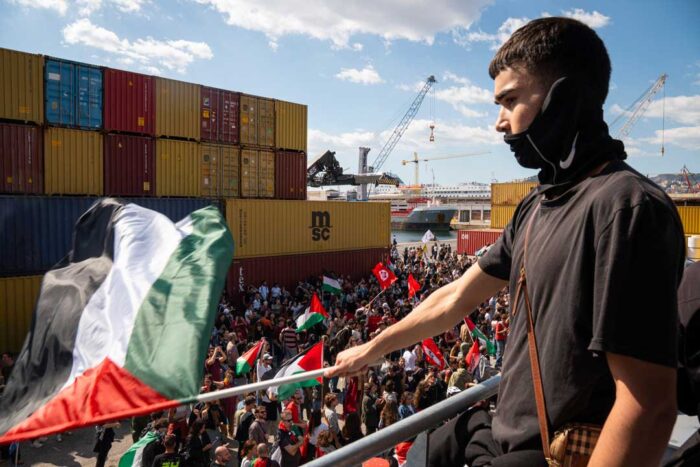
The ground crew of the Global Sumud Flotilla has turned into a multitude: students, the world of culture, logistics workers and trade unions. The strike is social. This is certainly a movement against war and against the militarisation of Europe.
It is also a post-globalisation movement: a movement that has understood that the West is in decline and that the world is now multipolar. It is a movement that rejects the techno-supremacist idea that the only solution for the West is to provoke a third world war, as if it were a competition to see who has the most beautiful bunker.
It is a movement that has understood that international law is in crisis, if not already dead. The Europe that emerged after the Second World War was based on two fundamental pillars: the UN and the unanimous condemnation of the Holocaust. Today, it is betraying both of them irreparably. If the West renounces international law and Israel commits the crime of repeating the Holocaust on another people, then Europe loses its very raison d’être.
For this reason, this is also a movement against the neoliberal left. It is a strike with immediate and concrete demands—such as stopping a genocide that is taking place before our very eyes—but also a movement that calls for the invention of a new cultural paradigm. It is clear that the hegemonic political culture is completely inadequate to deal with the history we are experiencing. The alternative offered to us between the fascist international of Trump, Meloni and Netanyahu, and a neoliberal left that is submissive and servile to the processes of militarisation, privatisation, property, gentrification and the destruction of welfare, is not an alternative.
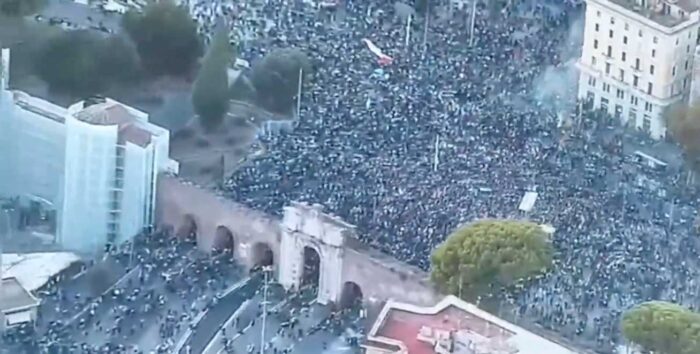
Although the mainstream media have slowly surrendered to some evidence—it took them two years to understand that genocide denial was untenable—it is clear that they are completely controlled by this false alternative: the extreme right and the neoliberal centre-left.
Being constituent means that movements create assemblies to which all levels of politics must be functional. It is not representative politics that dictates the agenda, but rather party projects that must take on and make the political agenda of the movements their own. Today, we should open a thousand assemblies to build this agenda and demand that party organisations take it on. If the parties are unable to do so, then it is time to create new ones.
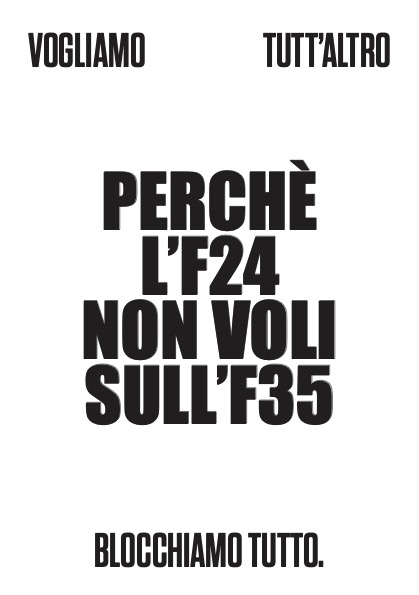
What is the public demanding? And why are European governments so timid?
First and foremost, this movement is calling on the Italian government and public institutions to divest from trade agreements with Israel, particularly from the supply of military equipment. This is a direct attack on the heart of the economic and strategic policy of Italian and European governments. On the one hand, because the industrial and energy policies of ENI and Leonardo are complicit in genocide; on the other, because the public is loudly proclaiming that militarisation policies are being pursued at the expense of welfare. The shift of public spending towards the military and security apparatus, to the detriment of education, culture, health and infrastructure, is the dream of this authoritarian right wing: governments that repress social unrest while privatising all welfare for the benefit of the private industrial sector.
These squares are rebelling against an idea of living in which the police defend the interests of a few CEOs barricaded in smart cities for the privileged, while the rest of the population is sacrificed. It is the same logic that Israel is already applying with its colonial settlements in the West Bank and wants to replicate with the future “Gaza Riviera.”
The project against which these squares are rebelling is transnational: against the alliance between the extreme right in the United States, religious fundamentalism and security techno-solutionism. This means that the policies of privatisation of services, financial speculation on real estate and platform capitalism have gone to war and now govern the main deviant democracies of the West.
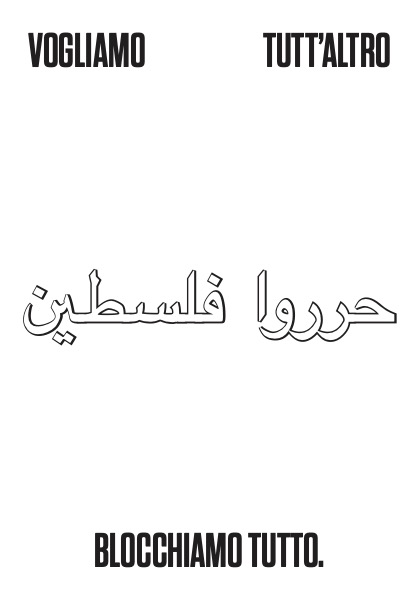
The rebellion of this grassroots, constituent movement knows it must measure itself against this monstrous body—and knows it must do so now. For this reason, the Flotilla has taken on a dimension of global resistance, capable of incorporating all possible levels of organisation: it has catalysed attention on concrete action, while at the same time demonstrating the existence of a multitudinous ground crew, with fluid and indefinable boundaries.
This movement has the maturity not to fragment, to show its face in large convergences, becoming a tide, as well as to hide and resurface like a karstic river. From the river to the sea, to live in a world free from oppressors.


